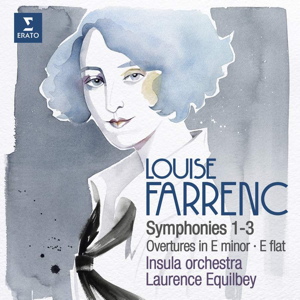
Louise Farrenc (1804-1875)
Symphony no. 1 in C minor, op. 32 (1841)
Symphony no. 3 in G minor, op. 36 (1849)
Symphony no. 2 in D, op. 35 (1845)
Ouverture no. 1 in E minor, op. 23 (1834)
Ouverture no. 2 in E flat, op. 24 (1834)
Insula Orchestra/Laurence Equilbey
rec. 2021/22, Boulogne-Billancourt, France
Erato 5419752210 [2 CDs: 113]
Both John Quinn (review) and Michael Wilkinson (review) enthusiastically welcomed Erato’s issue of the First and Third symphonies in 2021 and John then recently hailed their inclusion in the recent double CD re-packaging of them along with the newly recorded Second and two overtures by Louise Farrenc. I refer you to those reviews for more background information regarding the composer to avoid needless repetition. Both note the prevailing influence of contemporary German composers, starting with Beethoven but I agree that the listener is more often put in mind of the symphonies of Schubert and, especially Mendelssohn, such is the delicacy, rhythmic spring and forward-moving energy of Farrenc’s muse.
This is stimulating, approachable and highly varied music which evinces all the recognisable tropes of early 19C Romantic music without ever sounding dull or derivative. There is no sense of pastiche here, nor does the music require any special pleading based on gender politics; the composer’s sex is irrelevant, in the best application of the word, as the symphonies stand up very well for themselves. It is true that their form is conventional but they embrace a whole gamut of moods and effects couched in highly sophisticated orchestration. The stern, pacing opening of the First patently owes some debt to Beethoven and the slightly raw textures of the period instruments employed here add impact and tension – especially the percussion using hard sticks. There is a real sense of drive and progression in the movement; it always feels as if it is going somewhere and arrives at a satisfying, if rather conventional, conclusion. The slow movement unfolds in broad, lyrical fashion and the dusky tones of the period woodwind lend plangency. The Scherzo-Minuetto is first rustic and rumbustious, the Trio more graceful; the finale is driven, revealing heroic pretensions in the vein of Mendelssohn’s more vigorous mode but there are also moments of repose and charm with woodwind solos. It is not perhaps, major music but it is very well crafted and invariably diverting and absorbing.
I am inclined to agree with JQ that the Third is the superior work; enjoyable as the First is, it is darker, more complex, original and sophisticated – and as the shade of Beethoven hovers nearer here, you could easily believe that it is a lost symphony from his youth, newly rediscovered. The slow movement breathes contentment but I wonder whether for all its interesting key changes and harmonies its melodies could not be more inventive and memorable. The Scherzo scurries along engagingly, lifted by cheeky pizzicato passages, and at under seven minutes hasn’t time to outstay its welcome. The finale is similarly pithy and the lower strings are made to work hard but they are up to the challenge. The coda is sparkling.
Laurence Equilbey directs her period band with great verve and attack; the players really sound as if they are enjoying playing the music. My only mild reservations concern an occasional slightly rough patch and the noticeable absence of vibrato in the long lines of the Adagio cantabile movements, but neither feature compromises the listener’s pleasure.
The sound in terms of clarity, depth and balance is exemplary; there is nothing more to add.
As with all such re-issues, the only potential drawback – and indeed, irritation – derives from the fact that anyone who bought the first issue will have wished they had waited for the newer “twofer” issue which is offered at the same price as a full-price CD – so as much as I can endorse the quality of the music-making here, I should urge you to buy that instead – although if you just want to sample only two of the symphonies, I notice that copies of the single CD are now on the market at a knock-down price…
Ralph Moore
Previous reviews: John Quinn (May 2023) ~ Gwyn Parry-Jones (June 2023)
Help us financially by purchasing from




















